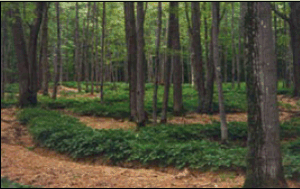Green Horizons
Volume 18, Number 3Fall 2014
Agroforestry opportunity created through land gift
By GENE GARRETT, DUSTY WALTER
The Center for Agroforestry knows the importance of the old adage, "seeing is believing." With this in mind, its leadership envisions demonstration areas for the five agroforestry practices distributed throughout our state: alley cropping, riparian forest buffers, windbreaks, silvopasture and forest farming. Each has an important economic, environmental and biological contribution when properly designed and positioned on the landscape.
Forest farming, the practice of growing high-value, shade tolerant specialty crops under a forest canopy, is especially well suited to Missouri. With 14 to 15 million acres of forest land, most of which is unmanaged and owned privately, a unique opportunity is available for landowners to place their timber under management while creating conditions favorable for growing commercially valuable plant species on the forest floor. While the ideal light requirements in the understory may be lacking, they can be created through the proper application of timber stand improvement (TSI, thinnings to improve forests). Shade tolerant specialty crops like gourmet mushrooms, medicinals or landscaping species can be grown as cash crops while waiting for the harvest of trees that are managed for valuable sawlogs and veneer logs.
A 560-acre farm that has been pledged to UMCA is rapidly transitioning from a farm of unmanaged forests and fields to a forest farming enterprise, as part of the vision to increase agroforestry demonstrations. This farm will demonstrate the benefits of combining good forest management with the planting of commercially valuable, shade tolerant cash crop species on the forest floor.
The farm is a future gift from Douglas T. Allen, who believes that when agroforestry principles and
practices are properly applied, they can provide "new approaches" to creating income, while improving the environment and enhancing wildlife habitat and food.
 |
Photo courtesy of Gene Garrett, Dusty Walter |
An example of a forest intentionally managed to |
In honor of the donor, the farm has been named The Allen Research and Education Project Site. Allen's vision is to create a "showplace" that will demonstrate to future generations life in harmony with the environment, while successfully providing for families.
The Allen Project Site located near Laurie, Mo. has already seen the replacement of 80 acres of Kentucky 31 tall fescue with more wildlife friendly forbs and tall-grass prairie species. In addition, extensive "feathering" of the field borders has been completed by either cutting and dropping undesirable trees, or planting species like elderberry, wild plum, false indigo and others along the field edges. Both approaches dramatically increase the food and habitat for many wildlife species but are especially beneficial to young quail, rabbit and turkey in need of thickets to protect them from predators.
With the management needs completed for the open fields, the forested land has now been "cruised" for stocking levels and other management considerations, broken into stands (areas with similar species and conditions) for management and prioritized for TSI. This information has been compiled to create a forest management plan which will guide timber management decisions for the near future. All stands will receive TSI but all will not be placed under forest farming management.
Some stands because of their slope aspect, soil depth, organic matter content, etc., are better suited than others. The severity of the TSI cut within each stand will, in part, be dictated by the light requirements of the shade-loving, understory cash crop species planted. Many of these species will be tested at the site.
The Allen Research and Education Site is designed to become a major demonstration area for forest farming. Aldo Leopold once wrote: "a farm should be more than a food factory," it should also be "a place of harmonious balance between plants, animals and people."
In time, the forest farming practices implemented will create harmony between plants, animals and people. They also will demonstrate significant income generation opportunities from the shade tolerant cash crop species and the overstory trees. All of this will occur as a result of Allen's vision, his land gift and application of an agroforestry practice.